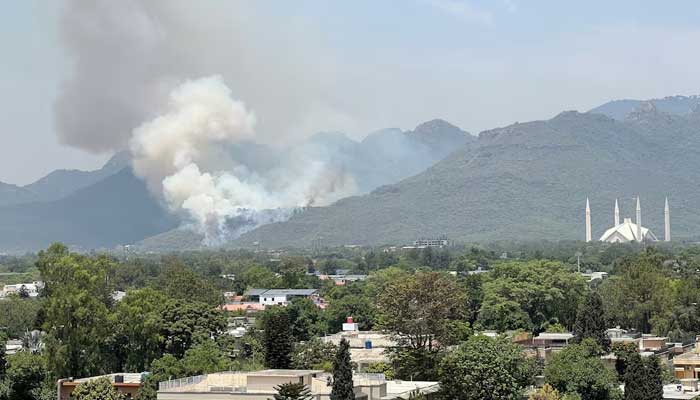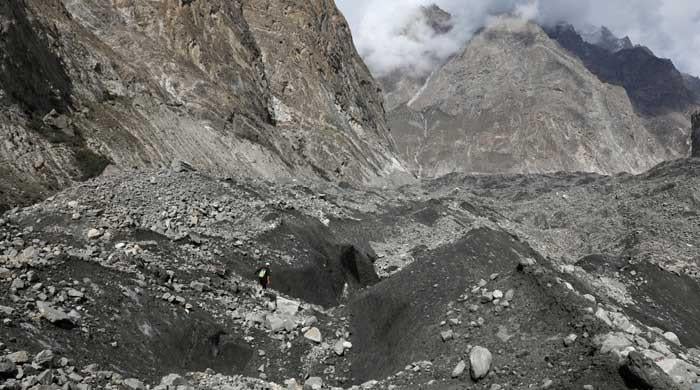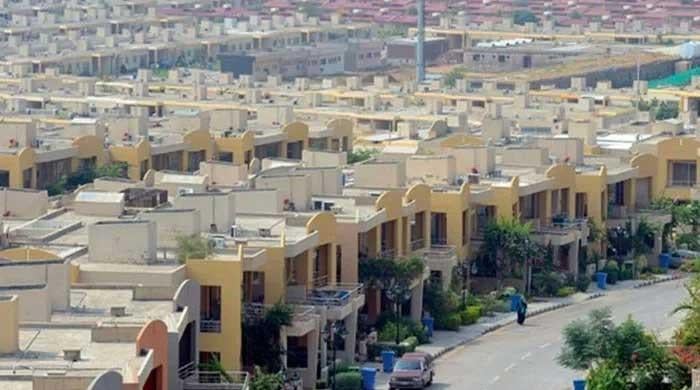Conservation for cash: Pakistan's untapped biodiversity credit opportunity
Alliance defines a biodiversity credit as proof of meaningful, measurable, lasting and additional nature conservation efforts
May 22, 2025

As Pakistan’s rich ecosystems from Khyber-Pakhtunkhwa’s chilgoza pine forests to the Indus Delta face mounting threats from relentless deforestation and climate change, a potential financial lifeline discussed at the recent CBD COP16 summit remains largely untapped. Even as countries worldwide are embracing “biodiversity credits” – verifiable instruments that reward measurable positive impacts on nature – to fund conservation efforts, Pakistan’s participation remains minimal despite having plenty to gain.
Global push for biodiversity credits
At COP15 in 2022, countries adopted the Kunming-Montreal Global Biodiversity Framework (GBF), setting a vision for living in harmony with nature by 2050 through four goals and 23 targets by 2030. Target 19 requires developed countries to fund biodiversity protection in developing nations for which the GBF Fund was established. But contributions remain significantly below the needed amounts.
At COP16, developing countries requested both increased funding and easier access to existing resources. To address the funding shortfall, discussions focused on innovative financing mechanisms like biodiversity credits and offsets, green bonds, benefit-sharing arrangements and payments for ecosystem services.
According to market projections, these nature-based credits could become a significant funding source as companies seek to demonstrate environmental responsibility. For instance, by 2050, global demand for these could reach USD 180 billion per year.
The Biodiversity Credit Alliance (BCA), formed to implement the GBF targets 19 (c) and 19 (d), that encourage private investment through biodiversity credits with social safeguards, aims to build a strong and fair biodiversity credit market on scientific principles.
How biodiversity credits work
Supported by international agencies including the Swedish International Development Cooperation Agency and the UNDP, the Alliance defines a biodiversity credit as proof of meaningful, measurable, lasting and additional nature conservation efforts like protecting forests or restoring wetlands or recovering wildlife.
These efforts must meet three essential conditions: measurable with solid evidence, create lasting positive impact and deliver outcomes beyond what would have occurred naturally.
To strengthen this market, France and the UK established an expert forum, the International Advisory Panel on Biodiversity (IAPB) credits in 2023. That then launched a framework for a high-integrity biodiversity credit market at COP16 on October 24. This framework introduces 21 principles organised around three core pillars: verified positive outcomes for nature, equity and fairness for people and good market governance.
Manesh Lacoul, the exceptionally soft-spoken coordinator of the Alliance, spoke to me in such a hushed tone that I had to strain to catch his words. He shared how they worked closely with indigenous peoples and local communities through a diverse advisory panel of over 40 members from across the globe to develop their high-integrity principles.
The IAPB requires verification certifications proving real conservation results. Credits must be backed by science and meaningfully involve local communities in leadership roles.
A key challenge addressed at COP16 was the controversial issue of biodiversity offsetting, which are regulated compliance schemes that require companies to invest in biodiversity improvements to compensate for their negative impacts on nature. Principle 2 of the framework requires clear eligibility rules for participating organisations and transparency in how credits are created, sold and used. It also questions what claims buyers can make – whether purchasing credits truly makes a company “nature positive” or simply a supporter of conservation projects.
While a working paper, titled “high level principles to guide the biodiversity credit market”, establishes that nature-based credits are used properly and responsibly to achieve real benefits for nature, several important questions remain for future guidelines. These include:
- ensuring fair exchanges in what kind and how much biodiversity was lost
- standardising measurements of corporate biodiversity footprints
- distinguishing between different kinds of credits
- establishing clear rules for what companies can say publicly when they buy credits and
- verifying that companies are doing what they are claiming
Biodiversity credits have multiple uses beyond just offsetting environmental damage, said Josh Brann from BCA. He further explained that these credits can attract funding from philanthropic organisations and voluntary applications such as insetting (see below, number three).
In its report, the IAPB identifies the following three main applications for nature-based credits:
- Evidence-based contributions: companies can use biodiversity credits to support nature-positive actions beyond their direct impact, such as outside their factories or supply chains. These contributions may align with national or biodiversity goals like habitat restoration or species protection. Unlike general donations, credits are backed by verified outcomes, ensuring transparency. However, they must not be misused to falsely claim offsets for environmental damage elsewhere, which would constitute “greenwashing”.
- Local compensation for direct impact: credits help compensate for unavoidable damage caused by development but only after following the following mitigation hierarchy: avoid, minimise, restore and then compensate. The International Advisory Panel on Biodiversity prefers to call this “local compensation” over offsetting to emphasise strict conditions. These credits must ensure measurable biodiversity outcomes, aiming for no net loss or a net gain. Compensation should be “local to local” and “like for like”, meaning biodiversity losses must be addressed in the same ecosystem using ecologically similar methods. Projects must follow national policies with strong oversight. While international funding can support local compensation, IAPB rejects cross-border biodiversity use, unless within a shared transboundary ecosystem. Credits cannot justify avoidable harm or replace real action, it says. Voluntary compensation must be within a strict regulatory framework. IAPB sees biodiversity compensation as a future use for credits.
- Supply chain insetting: Insetting is when companies invest directly in biodiversity within their supply chains, like forest restoration or eco-friendly farming, instead of buying credits to offset damage elsewhere. This helps companies manage their reliance on natural resources, strengthens supply chain resilience, reduces ecosystem risks and supports sustainability standards such as TNFD, ISSB and ESRS[1]. According to IAPB feedback, many businesses view insetting as a step towards more sustainable operations with lower environmental impact.
Colombia’s success story: guidelines for Pakistan
Mariana Sarmiento, an IAPB member, founded Terrasos, an environmental consultancy focused on biodiversity based in Colombia. In 2014, Terrasos initiated the first Habitat Bank in Colombia and Latin America. One such bank was along the River Metica, which initially conserved 600 hectares.
Today, Terrasos protects nearly 7,000 hectares across Colombia and leads regional biodiversity conservation projects. In an interview with The Citizenry, the soft-spoken and detailed-oriented Sarmiento explained that Colombia’s Habitat Banks are 30-year conservation and restoration projects that issue biodiversity credits to offset environmental damage from development projects related to the mining or power sector.
She further said that Colombian regulations require developers to offset their environmental impacts at ratios between 2:1 and 10:1, depending on the ecosystem’s vulnerability. For instance, if a road project damages one hectare, the developer may be required to restore ten hectares of a similar habitat to maintain ecological balance.
Attending every session on biodiversity credits at COP16, the indefatigable expert clarified that Habitat Banks are not financial institutions but actual conservation sites that efficiently pool resources from multiple developers. Companies can either handle restoration themselves or buy credits from established Habitat Banks, payments linked to achieving specific conservation milestones.
The funds generated support conservation activities including reforestation, building firebreaks, patrolling protected areas and environmental monitoring. These banks establish land use restrictions with landowners and provide employment for local communities as land stewards and labourers, offering economic opportunities alongside environmental benefits.
In Colombia, companies must compensate for ecological damage to receive environmental permits – it is legally binding and not optional. While Habitat Banks primarily focus on biodiversity compensation rather than social displacement, they provide indirect community benefits through job creation and land partnerships. However, Sarmiento noted that addressing displacement or resettlement of affected populations remains the responsibility of developers and government authorities.
India’s strategy for biodiversity funding
The Indian government, through its Ministry of Environment, Forest and Climate Change, launched the Green Credit Programme in 2023 to incentivise voluntary environmental actions such as reforestation and water conservation. Participating individuals and organisations receive tradable “green credits” for their efforts, similar to the international market-based “biodiversity credits” framework. The Indian Council of Forestry Research and Education, under the environment ministry, oversees the programme’s implementation, management and monitoring.
This government-led programme features a digital land bank where forest departments register degraded forest areas for voluntary plantations. Through an online portal, government bodies, NGOs, private companies and individuals can select plantation sites and contribute to reforestation efforts.
Thus, the Green Credit Programme incentivises tree planting, following guidelines set by the administrator, that is the Indian Council of Forestry Research and Education, for which there is a web platform and registry to streamline registration, verification and monitoring.
As compared to global biodiversity credit frameworks that are still developing standards, India has operationalised the programme through digital platforms.
But then experts in India question the programme’s environmental integrity, citing unresolved regulatory gaps in its methodology. They point out that the final tree planting guidelines lack key details from the earlier draft, such as plant survival rates and project tenure. This is similar to the concerns about verification standards in global biodiversity credits frameworks.
Local projects with biodiversity credits potential
Pakistan currently has no official biodiversity credit projects but it has established conservation frameworks that could potentially evolve into such initiatives. Existing carbon credit initiatives, such as the Delta Blue Carbon Project in the Indus Delta, already contribute to biodiversity restoration. This 60-year initiative aims to plant 500 million mangrove trees, generate carbon credits and support over 100,000 people across 100 villages. It will also help prevent habitat loss and restore fragile ecosystems.
Carbon credits function as a tool for reducing greenhouse gas emissions by allowing companies or countries to invest in projects such as reforestation and clean energy that either avoid or remove carbon dioxide from the atmosphere. These credits are tradable on global markets, effectively serving as an international coupon for climate action.
Similarly, the Billion Tree Tsunami project seeks to plant 10 billion trees nationwide, reinforcing Pakistan’s commitment to large-scale environmental restoration. These initiatives demonstrate that Pakistan has foundational programmes that could be expanded to integrate biodiversity credits.
Pakistan’s biodiversity gaps & legal pathways
Pakistan’s current approach to environmental compensation falls short of addressing biodiversity loss comprehensively. A review of Environmental Impact Assessment (EIA) reports by The Citizenry revealed that the only compensation requirement for development projects is planting five trees for every one lost — an overly simplistic measure that fails to account for broader ecological damage.
Seasoned environmental expert Saquib Ejaz, who prepares EIAs for Karachi-based projects, noted that there was no clear “thumb rule” for biodiversity compensation within existing policies or laws.
Supporting this view, environmental engineer and EIA expert, Shahid Lutfi said there was no technical basis for the practice of planting five trees to compensate for one lost. A highly regarded veteran in the field, he pointed out that biodiversity loss cannot be measured simply in terms of individual trees, as “a single tree supports birds, their nests, insects and other organisms that form an entire habitat,” adding that a tree’s age must be considered in any compensation model as a tree carries both environmental and economic value.
On the mitigation hierarchy (avoid, minimise, restore and compensate), Lutfi in his soft-spoken voice, said that every EIA consultant is expected to follow this fundamental procedure, “regardless of whether it exists in any policy or law”. He explained that EIA consultants conduct risk assessments and evaluate alternatives, which are incorporated into their reports. “If no viable alternative exists, then we allow for biodiversity loss,” he said. However, “most EIAs are treated as mere formalities by project proponents and government authorities.”
Lutfi referenced the Pakistan Environmental Protection Act, 1997, which outlines guidelines for EIA preparation. While the Act does not explicitly mention the mitigation hierarchy, it does cover essentials such as alternative site selection, impact assessment, remedial measures, consensus-building, dispute resolution and mitigation strategies.
On the government side, when Sindh Forest Department’s chief conservator, Riaz Ahmed Wagan, was asked about biodiversity loss and biodiversity credits, he acknowledged that biodiversity loss carries economic value. A technically proficient expert, he cited the example of a highway project in Sindh that was set to pass through 150 acres of forest land. He explained that the forest department had estimated the biodiversity loss at PKR 1,200 million and demanded this amount from the project proponent before issuing a No Objection Certificate, which ultimately led to a revision of the project design. Meanwhile, he observed that the concepts of biodiversity loss and biodiversity credits have yet to be formally recognised in existing environmental laws or policies and stressed the importance of their inclusion.
Looking beyond current practices, according to The Citizenry’s research Pakistan does have a legal foundation that could support biodiversity protection and create a compensation framework. Section 21(2) of the Sindh Wildlife Act grants full protection to the province’s wildlife and Schedule IV expands this protection to all forms of biodiversity, including land, water, genetic and cultural diversity. Although these provisions prohibit biodiversity exploitation unless permitted by future legislation, they remain underutilised in practical conservation efforts.
Further strengthening this framework, the Sindh Wildlife Protection, Preservation, Conservation, and Management Rules, 2022 define “cultural diversity” in line with the Convention on Biological Diversity. This includes the traditional knowledge, lifestyles and economic activities of people who depend on forests. If properly enforced, this provision could serve as a safeguard against biodiversity loss.
To establish an effective biodiversity credit system, Pakistan must bridge the gap between existing legal protections and practical implementation. Incorporating biodiversity credits into EIAs would ensure that conservation is not treated as an afterthought but as a fundamental requirement for development. Strengthening regulatory frameworks and enforcement mechanisms could transform existing legal provisions into actionable tools, helping Pakistan move beyond token efforts like tree planting and towards meaningful ecosystem restoration.
Integrating credits in Karachi
When the Citizenry discussed with Colombian expert Sarmiento about biodiversity losses along the River Malir in Karachi – where expressway construction in the riverbed displaced small-scale farmers to benefit elite housing developments – she suggested her pioneering Habitat Bank model as an alternative approach.
If Colombia’s system were applied in Karachi, the Sindh government would need to formally account for both the ecological and social impacts of the Malir Expressway, regardless of its funds through private bank loans. The provincial government would either purchase nature-based credits or directly restore a comparable ecosystem to offset environmental damage.
Indigenous voices raise concerns
At the CBD COP16, indigenous alliances strongly opposed biodiversity credits, particularly their use for offsetting environmental damage. India’s Souparna Lahiri, a climate campaigner and adviser at Global Biodiversity Forest Coalition, stood apart from suit-wearing attendees clad in a simple shirt and khaki trousers, who offered a critical perspective.
Lahiri explained that biodiversity offsetting itself isn’t new but “what is new is biodiversity credit”, explaining that these credits extract financial value from offsetting practices and turn biodiversity into tradable commodities. This means credits can be freely bought, sold and used to justify environmental destruction elsewhere.
With an unfiltered stream of thought, he criticised governments for viewing natural resources mainly as economic assets. He cited India’s 2009 REDD+[2] climate submission to the UN[3] which argued that without deforestation for infrastructure development, the country would lose “associated benefits”, treating conservation as an economic sacrifice that warrants compensation.
Lahiri argued that biodiversity finance prioritises securing funds over protecting nature, often serving economic interests. He criticised the use of limited public funds to “de-risk” private biodiversity investments, where governments must commit their own funds as a guarantee for private sector involvement. He warned that this approach subsidises corporate profits rather than directly funding conservation.
He highlighted that Target 19 of the Global Biodiversity Framework, which requires developed nations to provide USD 20 billion annually by 2025, increasing to USD 30 billion by 2030, is being leveraged to attract private investments of USD 170 billion. However, he cautioned that once governments commit public money, they often weaken environmental regulations to ensure project success, putting biodiversity at greater risk.
Sounding deeply connected to the natural world, Lahiri also condemned corporate offsetting, where companies destroy ecosystems in one area while claiming restoration elsewhere, such as planting trees or conserving wetlands. “You cannot scientifically replicate nature just a few kilometres away,” he said, especially for habitats supporting birds, bees and animals. He emphasised that true forest restoration happened through natural regeneration, not artificial plantations. Yet, biodiversity finance increasingly funds projects labelled as “conservation” despite continuing harmful practices, he added.
Lahiri criticised organisations like the International Union for Conservation of Nature for using donor funds to establish protected areas while evicting Indigenous Peoples and Local Communities (IPLCs) like erstwhile colonialists. These areas are then used to claim credits meant to offset destruction elsewhere. He questioned how one unit of conservation could truly balance one unit of biodiversity loss, especially when no clear metrics exist for valuing wetlands, species or habitats, unlike carbon, which can be measured.
Finally, he warned that biodiversity offsets, like carbon offsets, create financial schemes that exploit IPLCs. With little public funding for these communities, offset companies step in, promising restoration in exchange for money. Yet, IPLCs often lack understanding on fund allocation, and in carbon offset projects, only 10 to 20 per cent of funds reach them, often benefiting a few leaders while dividing communities further.
Local fishermen reject biodiversity offsets
Chairman of the Pakistan Fisherfolk Forum, Mehran Ali Shah – a young dynamic fisherman, emerging as a leader within his community – echoed the concerns raised by Lahiri, reinforcing the argument that biodiversity credits often prioritise economic interests over true conservation. Like Lahiri, Shah unequivocally critiqued the idea that ecosystems can be artificially replicated elsewhere, highlighting how biodiversity offsets could accelerate environmental destruction rather than prevent it.
He had seen his late father, Muhammad Ali Shah, dedicate his life to defending indigenous fishermen’s rights in Karachi, a struggle he now wants to carry forward. His father witnessed firsthand how elite housing projects displaced local fishing communities.
Mehran Ali Shah, Chairman of the Pakistan Fisherfolk Forum, an alliance of indigenous fishers, dressed in black, interacts with community members. Photo credit: Mehran Ali Shah
When asked about his thoughts on the credits system, Shah responded without hesitation, “absolutely not”. He questioned how anyone could recreate a creek’s ecosystem in another, emphasising that no fisherman in his community would accept such an idea.
With knowledge drawn from experience, he pointed to the destruction caused by ports and commercial developments, stating that freshwater no longer flows into their creeks — once vital nurseries for fish and crabs. Mangroves have also been cleared in the name of development, he further said. “Biodiversity offsets will only open the floodgates to further damage of whatever little remains of our ecosystem,” he warned.
Going forward: Global biodiversity credit market
The Biodiversity Credit Alliance aims to strengthen demand for biodiversity credits, making them a viable tool for closing the nature finance gap and achieving GBF Targets 19 (c) and (d) — mobilising private sector finance and promoting innovative financial mechanisms.
This year, BCA plans to leverage its network to identify and share experiences from various biodiversity credit initiatives through knowledge pieces and case studies. By the end of 2025, it seeks to collaborate with partners and market participants to establish clear ground rules for piloting biodiversity credit transactions under controlled conditions.
Biodiversity credits have the potential to be a valuable mechanism for financing biodiversity conservation and restoration. A sustainable market requires large-scale adoption, which in turn will require widespread confidence that biodiversity credits are effective and aligned with societal goals for nature. Therefore, it is crucial that the market has an agreed-upon framework to establish what a high quality and High Integrity Credit is, and how they can be used to generate High Integrity claims. At the same time, biodiversity is highly localised and difficult to distill into numbers, meaning that guidelines also need to be flexible enough to accommodate different contexts and ecosystems.
It has been close to two years since the Global Biodiversity Framework was agreed upon at COP15 and biodiversity credits were identified as a tool that could help close the biodiversity finance gap.
Accompanying that announcement, the World Economic Forum (WEF) published a set of high-level governance and integrity principles to guide the nascent market for voluntary biodiversity credits, focusing on principles for governance, equity and inclusion, and verification.
Since then, the market for biodiversity credits has grown rapidly, with a proliferation of credit methodologies, project standards and pilot projects being developed, both in the voluntary and regulatory markets.
It is crucial that the emerging market learns from the many lessons associated with the development of the voluntary carbon market, to avoid instances of low quality and integrity leading to a lack of trust, and doubt over the tangible benefits from projects.
To provide reassurance and clear guidance to the market, the BCA, the IAPB and WEF decided to collaborate through the High-level Principles working group, to develop this guidance. This has been done in consultation with BCA’s Communities Advisory Panel (CAP) to ensure the views of Indigenous Peoples and Local Communities are accounted for.
Lessons & opportunities: Pakistan’s biodiversity credits future
As neighbouring countries and global partners forge ahead with innovative financing mechanisms, Pakistan has the opportunity to design a system that absorbs from the successes and shortcomings of existing models.
The country’s threatened ecosystems could benefit from biodiversity credits that channel much-needed funding into conservation. However, as we have seen from global experiences, biodiversity credits require more than just good intentions to succeed.
Pakistan must learn from the lessons of carbon markets to avoid the pitfalls of low quality and integrity that can undermine trust.
The country needs an agreed-upon framework to establish what constitutes a high-quality credit and how these can generate legitimate claims.
The existing legal foundations in provincial wildlife acts provide a starting point but Pakistan needs to look beyond simple tree-planting measures. Projects like the Delta Blue Carbon initiative offer valuable lessons for developing an integrated approach that serves both environmental and community needs.
As organisations like the BCA work with indigenous communities to develop high-integrity principles globally, Pakistan has the opportunity to ensure its own approach prioritises verification standards and equitable benefit-sharing with local communities.
The question for Pakistan is how it can participate in biodiversity financing in a way that genuinely protects its natural heritage while ensuring that the proceeds reach the communities dependent on these ecosystems.
Oonib Azam is a Karachi-based journalist who reports on social justice, climate change and urban planning for The News. He tweets @OonibAzam_
This article was originally published by The Citizenry and has been reproduced on Geo.tv with permission.









